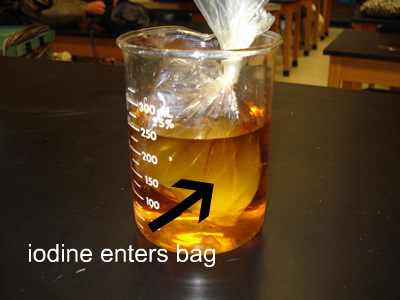Diffusion Lab KEY
This key goes with worksheet students use for the classroom activity: Diffusion in a Baggie. A comprehensive guide can be found at the blog article on diffusion. Photos on this page will help with the set up, procedure and explanation of results.
Prelab Observations: Describe what happened when iodine came into contact with starch.
the orange iodine combines with the white starch, turns purple
Procedure:
- Fill a plastic baggie with a teaspoon of corn starch and a half a cup of water tie bag. (This may already have been done for you)
- Fill a beaker halfway with water and add ten drops of iodine.
- Place the baggie in the cup so that the cornstarch mixture is submerged in the iodine water mixture.
- Wait fifteen minutes and record your observations in the data table
- While you are waiting, answer the questions.
Questions:
1. Define diffusion. movement of molecules from an area of high concentration to an area of low concentration
2. Define osmosis diffusion of water
3. What is the main difference between osmosis and diffusion osmosis involves water, diffusion can be in air
4. Why is iodine called an indicator? because it turns color in the presence of starch, it indicates
5. Molecules tend to move from areas of __high_ concentration to areas of _low___ concentration.
What's in the Bag?
We're going to think about concentrations now, which substances are more or less concentrated depends on which one has the most stuff in it.
1. Is the baggie or beaker more concentrated in starch? baggie
2. Is the baggie or beaker more concentrated in iodine? beaker
3. Iodine solution: is the baggie or the beaker hypertonic? beaker
4. Starch solution: is the baggie or the beaker hypertonic? baggie
5. Which one is hypotonic in relation to starch, baggie or beaker? beaker (hypo means less, beaker has less starch)
Make Some Predictions
1. If the baggie was permeable to starch, which way would the starch move, into the bag or out of the bag? ___out____
2. If the baggie was permeable to iodine, which way would the iodine move, into or out of the bag? _into___
3. If the baggie was permeable to iodine, what color would you expect the solution in the baggie to turn? __purple_ What about the solution in the beaker? ___stay same___
4. If the baggie was permeable to starch, what color would you expect the solution in the baggie to turn? __stay same___ What about the solution in the beaker? __purple_____
5. Make a prediction about what
you think will happen: answers vary, accept reasonable predictions
|
Starting
Color
|
Color
after 15 minutes
|
|
|
Solution
in Beaker
|
orange | orange |
|
Solution
in Bag
|
white | purple to black |
Post Lab Analysis
1. Based on your observations, which substance moved, the iodine or the starch? The iodine moved into the bag
2. How did you determine this? the starch turned purple
3. The plastic baggie was permeable to which substance? permeable to iodine
4. Is the plastic baggie selectively permeable? yes, it allowed iodine to pass through, but not starch
5. Sketch the cup and baggie in the space below. Use arrows to illustrate how diffusion occurred in this lab.

6. What would happen if you did
an experiment in which the iodine solution was placed in the baggie, and the
starch solution was in the beaker?
Be detailed in your description. In this case, the iodine would move out of the bag and turn the solution in the beaker purple
7. Why is it not a good idea to store iodine in a plastic bag? it would leak
